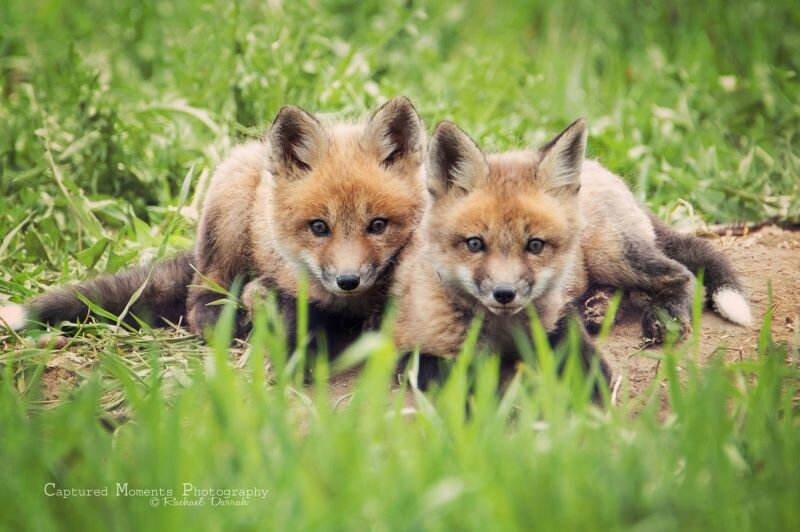Right about now Red Fox vixens are giving birth to a litter of four to five kits (even up to 10 in rare cases). The number of kits born is influenced by the number of foxes that occupy the particular area, and their food supply.
In the winter our foxes eat mostly Snowshoe Hare and deer carrion (the meat of dead deer). In summer they prey on small mammals, hares, birds, turtles, frogs, snakes, and even insects. They also eat eggs and fruit. They are the classic omnivore!
Kits are born in an underground den (usually on a sunny hillside in a woodland area) with an elaborate tunnel system (up to 25 feet long).
Spring is a time of year that foxes are working extra hard to find food because they are trying to provide for their growing kits. As a result, they are more frequently seen and observed near our homes (and, unfortunately our chicken coops).
There are ways to coexist with these mid-level predators, and many reasons to accept and appreciate their presence. Foxes and other predators provide important ecological functions such as rodent patrol (which in turn keeps diseases like Lyme in check).
That being said, problems can arise when foxes overpopulate an area, and become habituated to humans. Always keep your distance and admire them from afar.
I hope you enjoyed this Phenology Note!
Join me in witnessing the seasons of our wild world.
Posted regularly here, and on Facebook and Instagram:
Follow #ThePersonalEcologist & #PhenologyNotes
SIGN UP TO RECEIVE EVENT NOTICES & FREE HABITAT TIPS, TOOLS, AND TRICKS.
#ThePersonalEcologist
I co-create biodiverse habitats with eco-minded stewards throughout the Northeast - at any scale.
I have 30 years of experience and a lifelong commitment to wildlife conservation.
Read My Story.
-
Deborah
Perkins
- Dec 22, 2023 Storm Habitat: Nurse Logs, Dens, and More
- Aug 8, 2023 Beautiful Buttonbush in Bloom
- Jun 17, 2023 Snapping Turtles on the Move
- Feb 1, 2023 The True Harbingers of Spring: Chickadees
- Mar 20, 2021 The Power of Photoperiod
- Feb 19, 2021 The Golden-crowned Kinglet: A Royally Charming Winter Resident
- Feb 8, 2021 Subnivean Secrets
- Jan 9, 2021 Wild Reads: Ravens in Winter
- Oct 23, 2020 Flower “Beds” for Bumble Bees
- Oct 4, 2020 Wise Oaks, Clever Jays
- Sep 11, 2020 Goldenrods: Top Plants for Boosting Biodiversity
- Aug 25, 2020 Gentle Golden Wasps Adorned with Pollen
- Aug 1, 2020 Water for Wildlife - Birdbath Basics & More
- Jul 19, 2020 Fruits of the Forest
- Jul 11, 2020 Hungry Little Hummingbirds
- Jun 24, 2020 Hatching Out: Mother Nature's "Escape Room"
- Jun 12, 2020 Maine's Real Lupine Revealed
- May 31, 2020 Wild Geranium in Flower
- May 24, 2020 Moosewood Chandeliers
- May 17, 2020 Shadbush in Bloom
- May 7, 2020 Native Nectar for Queen Bumble Bees
- Apr 25, 2020 Waves of Warblers
- Apr 19, 2020 Attracting Bluebirds without Boxes
- Apr 12, 2020 Hungry Bears on the Move
- Apr 5, 2020 Bees on Red Maple Flowers
- Mar 27, 2020 Sky Dancing
- Mar 22, 2020 Fox Kits Being Born
- Mar 15, 2020 Corvids a-Courtin’
- Mar 8, 2020 Phenology Notes: Witnessing The Seasons of our Wild World
- Feb 5, 2019 Plan Your Habitat Garden
- Jan 2, 2019 Wild Reads: We Took to The Woods
- Nov 28, 2018 Winterberry: The Gift that Keeps on Giving
- Aug 16, 2018 Where Have All the Whip-poor-wills Gone?
- Jun 22, 2018 Give a Warm Welcome to Wild Bees (Super-pollinators Part 2)
- May 16, 2018 The Wonder of Wild Bees (Super-pollinators Part 1)
- Apr 19, 2018 Saving Songbirds Starts with Your Morning Coffee
- Mar 21, 2018 Wildlife Habitat Design in A Wounded World
- Feb 16, 2018 “Intelligent Tinkering” - How to Boost Biodiversity at Home (Leopold’s Wise Words Part 2)
- Jan 18, 2018 Carnivore Coexistence (Leopold's Wise Words - Part 1)
- Dec 14, 2017 Dead and Dying Trees are Key to Life
- Nov 14, 2017 A Top Threat to Biodiversity: Invasive Plants
- Oct 18, 2017 Hallowed Habitat
- Sep 21, 2017 Beechnuts - Superfood for Bears & Other Wildlife
- Aug 22, 2017 Baby Bats Need Love Too
- Jul 25, 2017 Bring the Magic of Fireflies Back Home Again



